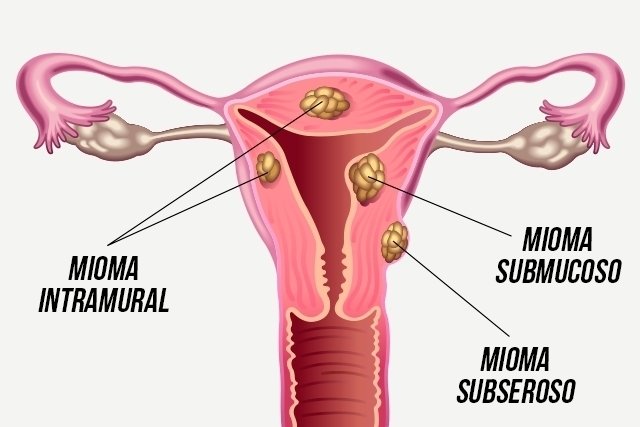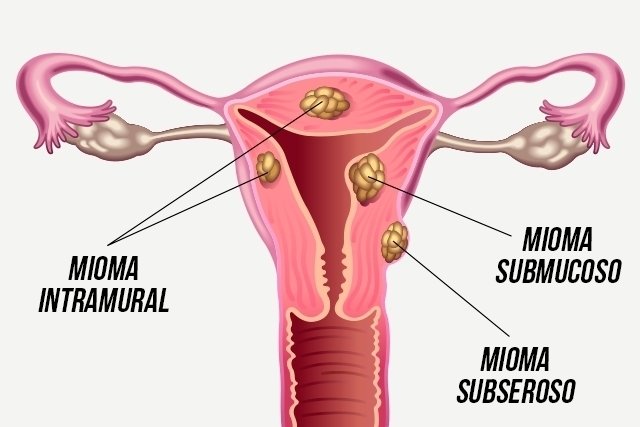Submucosal myoma is a benign tumor that develops within the muscular wall of the uterus (myometrium), and close to the endometrium, due to the proliferation of cells in the myometrium, leading to the formation of nodules inside the uterus and which can cause pelvic pain and excessive bleeding.
The exact cause of submucosal fibroids is not completely known, however, it is more common in black women or those who have a family history of fibroids, and some factors can increase the risk of its development, such as a very early first menstruation, obesity or disability. of vitamin D. Understand what myoma is and its causes.
The treatment of submucous fibroids must be carried out under the guidance of a gynecologist, who may recommend the use of medication to alleviate symptoms, or surgery.

Submucous fibroid symptoms
The main symptoms related to submucosal myoma are:
- Bleeding outside the menstrual period;
- Abundant blood flow during menstruation, and the presence of clots may also be observed;
- Menstrual periods that last more than a week;
- Pain, discomfort or feeling of pressure in the pelvis;
- Uterine cramps;
- Iron deficiency anemia, due to excessive bleeding;
- Pain in the lower back;
- Constipation.
Furthermore, submucosal myoma, especially when it is large, can cause increased urinary frequency or difficulty emptying the bladder completely, due to compression of the bladder, for example.
Submucosal fibroid and pregnancy
In the presence of submucosal myoma, a woman’s fertility is compromised. This is because the endometrium is compromised, which is the wall of the uterus in which the embryo is implanted. Therefore, women who have this type of myoma have more difficulty getting pregnant and are more likely to suffer miscarriages.
How to confirm the diagnosis
The diagnosis of submucosal myoma is made by the gynecologist through the evaluation of symptoms and through imaging tests, mainly ultrasound and diagnostic hysteroscopy, which is considered the main exam for detecting submucosal myoma, because it allows the internal visualization of the uterus and classification of the myoma in relation to the endometrium. Understand how diagnostic hysteroscopy is performed.
Classification of submucosal myoma
This type of myoma is located within the uterine cavity and can be classified into:
- Level 0when the myoma is located entirely in the uterine cavity, without any projection into the myometrium, compromising only the endometrium;
- Level 1when more than 50% of the myoma is found in the uterine cavity;
- Level 2when more than 50% of the nodule is in the myometrium.
The classification of submucosal myoma is done by the doctor through diagnostic tests. Also learn about intramural fibroids.
Possible causes
Submucosal myoma does not have a very well-established cause, however, it appears to be related to hormonal changes, such as estrogen and progesterone, and growth factors, such as EGF and IGF, causing the cells of the smooth muscle tissue that form the uterus to fail. multiply in a disorderly way, leading to the appearance of the tumor.
Some factors may contribute to increasing the risk of developing submucosal myoma, such as:
- Family history of myoma;
- Ethnicity, being more common in black women;
- Radiotherapy;
- Early menarche;
- Obesity;
- Vitamin D deficiency;
- Excessive consumption of alcoholic beverages.
Additionally, women who have never had children also appear to have an increased risk of developing submucosal fibroids.
How the treatment is carried out
The treatment for submucous fibroids is established by the gynecologist and is carried out through hysteroscopy, which corresponds to a surgical procedure, carried out under anesthesia or sedation, and which aims to remove the fibroid. Find out more about surgical hysteroscopy.
In addition, the gynecologist may recommend the use of some medications to alleviate symptoms by reducing the size of the fibroid or bleeding, in addition to improving the woman’s general condition so that the surgery is less invasive.
Bibliography
- AAGL: ADVANCING MINIMALLY INVASIVE GYNECOLOGY WORLDWIDE. AAGL Practice Report: Practice Guidelines for the Diagnosis and Management of Submucous Leiomyomas. The Journal of Minimally Invasive Gynecology. 19. 2; 151-171, 2012
- LIANG, B.; et al. Diagnosis and treatment of submucous myoma of the uterus with interventional ultrasound. Oncol Lett. 15. 5; 6189–6194, 2018
- THURKOW, A. L.; et al. Submucous myomas: diagnosis and therapy. Gynecological Surgery. 5. 93–102, 2008

Sign up for our newsletter and stay up to date with exclusive news
that can transform your routine!
Warning: Undefined array key "title" in /home/storelat/public_html/wp-content/plugins/link-whisper-premium/templates/frontend/related-posts.php on line 12
Warning: Undefined array key "title_tag" in /home/storelat/public_html/wp-content/plugins/link-whisper-premium/templates/frontend/related-posts.php on line 13




